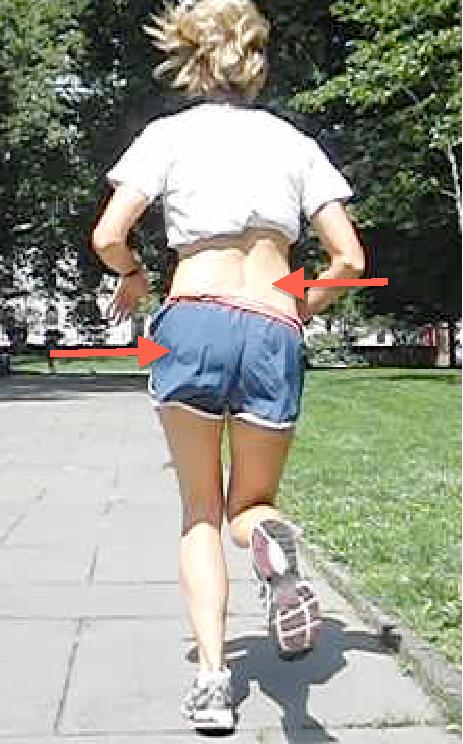Pelvic Unleveling?? Yikes!
 When your foot hits the ground lots of stuff happens. The focus of today's post is the pelvis and how it should remain level when running.
When your foot hits the ground lots of stuff happens. The focus of today's post is the pelvis and how it should remain level when running.
As one client put it, pelvic unleveling just sounds downright “unnerving”. The image of one hip that has lowered dramatically just doesn't look right. And for good reason!
What is happening, exactly?
Well, you know the sexy walk that models strut? This is that, only done unknowingly while running. Most definitely not sexy!
In a nutshell, the glutes (butt muscles) on the weight bearing leg are not doing their job of supporting the hip. Meanwhile, the core on the non-weight bearing side is asleep at the wheel and allowing the pelvis to drop. So you have two major players not doing their job of providing support and stiffness at the right time.
This issue is incredibly prevalent but may be tough to identify unless you have a highly trained eye or you have high speed video. And what's more, you can't simply make a “form change” and expect to fix the problem. More on that later...
Why should you care?
Quite simply, if this is your problem it's not a matter of “will you get hurt”, it's a matter of when. As you can imagine, your body wasn't designed to distribute all of the forces involved in this fashion. Will your knee take on more stress? Or will it be your back? Or maybe the foot?
Additionally, you should know that you're leaking energy with every stride. That's right, you're just giving it away. Wouldn't you rather channel that energy back into the ground and put it to use? An unstable pelvis represents a major loss of power because your body should behave like a stiff spring. So if you want to run farther or faster, this needs to be fixed!
How Does One Develop This Issue?
Most likely a person never learned the correct way to stabilize themselves on one leg. Their life never demanded the skill be learned. What I'm saying is that somehow, they made it all the way to adulthood without their lateral stabilization system (the muscles that prevent you from bending or shifting sideways) being challenged. Former non-athletes, swimmers and other people who never had to 'deal' with gravity are the most likely victims.
How Can It be Fixed?
I know! Side Planks, right? Uh, no. The deadlift? Fantastic guess :-) !! But, no.
Typical abdominal and butt exercises are nice and all but they do little to replicate the timing involved in the walking and running stride.
Ready for the simplest advice ever? Carry heavy things.
To be clear, there's much more to it than that. First, you need to be made aware of the compensation. Then, you need to learn how to stand (then walk) without the compensation.
In my experience, this running form issue, or pathological gait pattern (yeah, it is), is a symptom of a larger body-wide problem – weakness. But strength alone won't do the job. You have to put your body in a situation to react to the ground while loaded in a manner that will expose this particular weakness. In other words, it's not just strength you need, but timing and coordination.
There's a whole category of exercises called “carries” and “walks” that addresses this issue. Yup, our lives have become so cushy that we don't need to carry anything heavy anymore. So we needed to create an 'exercise'...
Here's a nice video demonstration of the suitcase carry. It's my favorite carry to introduce to first-time carriers. Notice how the weight does not touch the hip?
http://www.youtube.com/watch?v=FyK-synJ9fs
Most people, when carrying something heavy, will take the lazy route. They'll stick their hip outward, into the weight. The weight then effectively rests on the body, perpetuating the problem: a weak, uncoordinated core! Every time you carry a grocery bag you have an opportunity to train this quality. Do it!
Just Remember
Running is a highly athletic and coordinated complex movement ...when done right. The attitude that “anyone” can run leads many straight to the doctor's office. If you bring a body that is weak and full of compensations to running, well, good luck with that. Running needs to be respected for the high force, high repetition form of movement that it is. You need to be able to tolerate those forces appropriately – so do your carries!
PS: I am not a doctor and I am not your doctor so anything you read here should not be taken as medical advice. For that you need to visit YOUR doctor and ask them the questions. I have not examined you, I do not know you, I know very little about your medical status. So, do not hold me responsible for taking my advice when I have just told you not to! Again, I am NOT your doctor.

